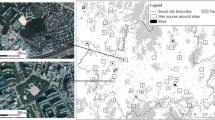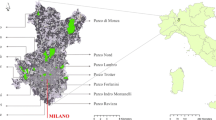Abstract
Urban vacant lots can vary considerably in their vegetation structure, from dense, shrubby habitats to wooded remnant fragments that may provide habitat for a variety of birds. By identifying which features promote diverse bird communities, we can determine at which scale management practices should focus and the necessary habitat structure and composition features. We surveyed 150 vacant lots throughout Baltimore, Maryland for their bird communities, lot vegetation, and landscape-level forest cover. An ordination of the bird community indicated a response to a gradient of canopy cover and canopy height at the vacant lot. We also found that forest cover within 100 m of the vacant lot was the most important predictor of abundance for five bird species of interest. Species richness was spatially autocorrelated among sites, indicating that bird communities may also be driven by species’ dispersal and environmental gradients across the city. Overall, bird communities are responding to habitat features across multiple scales, from the vacant lot vegetation, to landscape-level forest cover, to city-wide dynamics. Thus, we recommend management practices to focus on increasing city-wide forest cover in order to increase species richness, yet with awareness regarding where the lot occurs within the city.



Similar content being viewed by others
References
Accordino J, Johnson GT (2000) Addressing the vacant and abandoned property problem. J Urban Aff 22:301–315
Arca E, Battisti C, Fraticelli F (2012) Area-effect in breeding bird communities occurring in an archipelago of urban holm oak fragments (Rome, Central Italy). Life Environ 62:159–164
Baltimore Office of Sustainability (2009) The Baltimore sustainability plan. Baltimore, MD
Barth BJ, FitzGibbon SI, Wilson RS (2015) New urban developments that retain more remnant trees have greater bird diversity. Landsc Urban Plan 136:122–129
Bibby CJ, Burgess ND, Hill DA (2000) Bird Census Techniques. Academic Press Limited, Cambridge, UK
Blair RB (1996) Land use and avian species diversity along an urban gradient. Ecol Appl 6:506–519
Bolger DT, Scott TA, Rotenberry JT (1997) Breeding bird abundance in an urbanizing landscape in coastal Southern California. Conserv Biol 11:406–421
Boulinier T, Nichols JD, Hines JE, Sauer JR, Flather CH, Pollock KH (2001) Forest fragmentation and bird community dynamics: inference at regional scales. Ecology 82:1159–1169
Bowman AO’M, Pagano MA (2004) Terra incognita: vacant land and urban strategies. Georgetown University Press, Washington, D.C.
Bray JR, Curtis JT (1957) An ordination of the upland forest communities of southern Wisconsin. Ecol Monogr 27:325–349
Brodsky CC (2016) Urban vacant lots: ecological quality and social opportunities in Baltimore, Maryland. University of Missouri, Dissertation
Burkholder S (2012) The new ecology of vacancy: rethinking land use in shrinking cities. Sustain 4:1154–1172
Burnham KP, Anderson DR (1998) Model selection and inference: a practical information-theoretic approach. Springer-Verlag, New York
Chase JF, Walsh JJ (2006) Urban effects on native avifauna: a review. Landsc Urban Plan 20:202–226
City of Baltimore (2015) Open Baltimore. Baltimore, Maryland
Clergeau P, Jokimäki J, Savard JPL (2001) Are urban bird communities influenced by the bird diversity of adjacent landscapes? J Appl Ecol 38:1122–1134
Donnelly R, Marzluff JM (2004) Importance of reserve size and landscape context to urban bird conservation. Conserv Biol 18:733–745
Dwyer JF, Schroeder HW, Gobster PH (1991) The significance of urban trees and forests: toward a deeper understanding of values. J Arboric 17:276–284
Easton WE, Martin K (1998) The effect of vegetation management on breeding bird communities in British Columbia. Ecol Appl 8:1092–1103
ESRI (2011) ArcGIS desktop: spatial statistics. Environmental Systems Research Institute, Redlands, CA
Fiske IJ, Chandler RB (2011) Unmarked: an R package for fitting hierarchical models of wildlife occurrence and abundance. J Stat Softw 43:1–23
Fontana S, Sattler T, Bontadina F, Moretti M (2011) How to manage the urban green to improve bird diversity and community structure. Landsc Urban Plan 101:278–285
Garvin E, Branas C, Keddem S, Sellman J, Cannuscio C (2013a) More than just an eyesore: local insights and solutions on vacant land and urban health. J Urban Health 90:412–426
Garvin EC, Cannuscio CC, Branas CC (2013b) Greening vacant lots to reduce violent crime: a randomized controlled trial. Inj Prev 19:198–203
Gavareski CA (1976) Relation of park size and vegetation to urban bird populations in Seattle, Washington. Condor 78:375–382
Greenberg M, Lowrie K, Solitare L, Duncan L (2000) Brownfields, TOADS, and the struggle for neighborhood redevelopment: a case study of the state of New Jersey. Urban Aff Rev 35:717–733
Heckert M, Mennis J (2012) The economic impact of greening urban vacant land: a spatial difference-in-differences analysis. Environ Plann A 44:3010–3027
Hennings LA, Edge WD (2003) Riparian bird community structure in Portland, Oregon: habitat, urbanization, and spatial scale patterns. Condor 105:288–302
Huang Q, Swatantran A, Dubayah R, Goetz SJ (2014) The influence of vegetation height heterogeneity on forest and woodland bird species richness across the United States. PLoS One 9:e103236. doi:10.1371/journal.pone.0103236
Huang Y, Zhao Y, Li S, von Gadow K (2015) The effects of habitat area, vegetation structure and insect richness on breeding bird populations in Beijing urban parks. Urban For Urban Gree 14:1027–1039
James FC, Shugart HH (1970) A quantitative method of habitat description. Audubon Field Notes 24:737–736
Jasmani Z, Ravn HP, van den Bosch CCK (2016) The influence of small urban park characteristics on bird diversity: a case study of Petaling Jaya. Malaysia Urban Ecosys:1–17. doi:10.1007/s11252-016-0584-7
Jokimäki J, Kaisanlahti-Jokimäki M-L, Carbó-Ramírez P (2014) The importance of wooded urban green areas for breeding birds: a case study from northern Finland. In: Gil D, Brumm H (eds) Avian urban ecology: Behavioural and physiological adaptions. Oxford University Press, Oxford
Kang W, Minor ES, Park CR, Lee D (2015) Effects of habitat structure, human disturbance, and habitat connectivity on urban forest bird communities. Urban Ecosys 18:857–870
Kim G (2016) The public value of urban vacant land: social responses and ecological value. Sustain 8:486. doi:10.3390/su8050486
Kim G, Miller PA, Nowak DJ (2015) Assessing urban vacant land ecosystem services: urban vacant land as green infrastructure in the City of Roanoke, Virginia. Urban For Urban Gree 14:519–526
Kremer P, Hamstead ZA, McPhearson T (2013) A social–ecological assessment of vacant lots in New York City. Landsc Urban Plan 120:218–233
LaMontagne JM, Kilgour RJ, Anderson EC, Magle S (2014) Tree cavity availability across forest, park, and residential habitats in a highly urban area. Urban Ecosys 18:151–167
Leibold MA et al (2004) The metacommunity concept: a framework for multi-scale community ecology. Ecol Lett 7:601–613
Lerman SB, Warren PS (2011) The conservation value of residential yards: linking birds to people. Ecol Appl 21:1327–1339
Lerman SB, Nislow KH, Nowak DJ, DeStefano S, King DI, Jones-Farrand DT (2014) Using urban forest assessment tools to model bird habitat potential. Landsc Urban Plan 122:29–40
MacArthur RH, MacArthur JW (1961) On bird species diversity. Ecology 42:594–598
MacGregor-Fors I, Ortega-Álvarez R, Schondube JE (2009) On the ecological quality of urban systems: an ornithological perspective. In: Graber DS, Birmingham KA (eds) Urban planning in the twenty-first century. Nova Science Publishers, New York
Machtans CS, Villard MA, Hannon SJ (1996) Use of riparian buffer strips as movement corridors by forest birds. Conserv Biol 10:1366–1379
McCune B, Mefford MJ (2011) PC-ORD. Multivariate analysis of ecological data, Version 6 edn. MjM Software, Gleneden Beach, Oregon
Melles S, Glenn SM, Martin K (2003) Urban bird diversity and landscape complexity: species-environment associations along a multiscale habitat gradient. Ecol Soc 7:5. [online] URL: http://www.consecol.org/vol7/iss1/art5/
Minor ES, Urban D (2010) Forest bird communities across a gradient of urban development. Urban Ecosys 13:51–71
Moran PAP (1950) Notes on continuous stochastic phenomena. Biometrika 37:17–23
Mörtberg U, Wallentinus H-G (2000) Red-listed forest bird species in an urban environment — assessment of green space corridors. Landsc Urban Plan 50:215–226
Mörtberg UM, Balfors B, Knol WC (2007) Landscape ecological assessment: a tool for integrating biodiversity issues in strategic environmental assessment and planning. J Environ Manag 82:457–470
Newman GD, Bowman AO’M, Lee RJ, Kim B (2016) A current inventory of vacant urban land in America. J Urban Design 21:302–319
Ortega-Álvarez R, MacGregor-Fors I (2009) Living in the big city: effects of urban land-use on bird community structure, diversity, and composition. Landsc Urban Plan 90:189–195
Pagano MA, Bowman AOM (2000) Vacant land in cities: An urban resource. Brookings Institution, Center on Urban and Metropolitan Policy, Washington, D.C.
Pallagst K, Wiechmann T, Martinez-Fernandez C (2015) Shrinking cities: international perspectives and policy implications. Routledge, New York
Parker TS, Nilon CH (2012) Urban landscape characteristics correlated with the synurbization of wildlife. Landsc Urban Plan 106:316–325
Ralph, CJ, Droege, S, Sauer, J.R. (1995) Managing and monitoring birds using point counts: Standards and applications. USDA Forest Service Gen. Tech. Rep. PSW-GTR-149
Rega CC, Nilon CH, Warren PS (2015) Avian abundance patterns in relation to the distribution of small urban greenspaces. J Urban Plan Dev 141:A40150021–A40150028
Rega-Brodsky, CC, Nilon, CH (2016) Vacant lots as a habitat resource: Nesting success and body condition of songbirds. Ecosphere 7(11):e01578. doi:10.1002/ecs2.1578
Reis E, López-Iborra GM, Pinheiro RT (2012) Changes in bird species richness through different levels of urbanization: implications for biodiversity conservation and garden design in Central Brazil. Landsc Urban Plan 107:31–42
Rodewald P (2015). The Birds of North America: https://birdsna.org. Cornell Laboratory of Ornithology, Ithaca, NY.
Roth RR (1976) Spatial heterogeneity and bird species diversity. Ecology 57:773–782
Ryder TB, Reitsma R, Evans B, Marra PP (2010) Quantifying avian nest survival along an urbanization gradient using citizen- and scientist-generated data. Ecol Appl 20:419–426
Sandström UG, Angelstam P, Mikusiński G (2006) Ecological diversity of birds in relation to the structure of urban green space. Landsc Urban Plan 77:39–53
Schlesinger MD, Manley PN, Holyoak M (2008) Distinguishing stressors acting on land bird communities in an urbanizing environment. Ecology 89:2302–2314
Shwartz A, Shirley S, Kark S (2008) How do habitat variability and management regime shape the spatial heterogeneity of birds within a large Mediterranean urban park? Landsc Urban Plan 84:219–229
Sokal RR, Oden NL (1978) Spatial autocorrelation in biology: 1. Methodology. Biol J Linn Soc 10:199–228
Strohbach MW, Lerman SB, Warren PS (2013) Are small greening areas enhancing bird diversity? Insights from community-driven greening projects in Boston. Landsc Urban Plan 114:69–79
Szlavecz K, Warren P, Pickett S (2011) Biodiversity on the urban landscape. In: Cincotta PR, Gorenflo JL (eds) Human population: its influences on biological diversity. Springer, Berlin Heidelberg, Berlin, Heidelberg, pp. 75–101. doi:10.1007/978-3-642-16707-2_6
Tilghman NG (1987) Characteristics of urban woodlands affecting breeding bird diversity and abundance. Landsc Urban Plan 14:481–495
Troy A, Grove JM, O’Neil-Dunne J (2012) The relationship between tree canopy and crime rates across an urban–rural gradient in the greater Baltimore region. Landsc Urban Plan 106:262–270
U.S. Census Bureau (2014) State and county quickfacts. U.S. Department of Commerce, Washington, D.C.
Wu G, Holan SH, Nilon CH, Wikle CK (2015) Bayesian binomial mixture models for estimating abundance in ecological monitoring studies. Ann Appl Stat 9:1–26
Acknowledgements
This project was supported by the National Science Foundation Long-Term Ecological Research Program (DEB-1027188). We are grateful for the field assistance provided by E. S. Carpenter, A. Savage, J. Bos, E. Suzuki, C. Griffith, and S. Scully.
Author information
Authors and Affiliations
Corresponding author
Electronic supplementary material
Below is the link to the electronic supplementary material.
ESM 1
(DOCX 18.6 kb)
Rights and permissions
About this article
Cite this article
Rega-Brodsky, C.C., Nilon, C.H. Forest cover is important across multiple scales for bird communities in vacant lots. Urban Ecosyst 20, 561–571 (2017). https://doi.org/10.1007/s11252-016-0614-5
Published:
Issue Date:
DOI: https://doi.org/10.1007/s11252-016-0614-5




